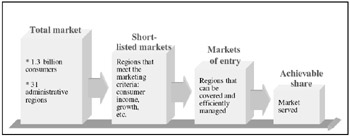Where is the market?
This may seem an obvious question requiring no answer, as everybody knows that China has a population of 1.3 billion and that must be the market. However, the reality is not so simple. Only a few companies can really consider selling to 1.3 billion people, while most will be working on gaining a share of the market. Where this share of the market should come from is really a question of where the market is.
All too often, a foreign company would think first of large urban centres like Beijing, Shanghai and Guangzhou as points of entry, and many have been given advice by various kinds of advisers or consultants to attack these large urban markets because they have the most affluent consumers. It is true that these large urban centres are the most dynamic local economies where opportunities exist. However, they are crowded not only with domestic players but also with international competitors . The trend of internationalized competition is more pronounced in the large urban centres than in other areas. The benefits and costs of entering these markets need to be carefully weighed against other alternative entry strategies.
On China's mainland there are 31 administrative regions, each with its own development policy and plan, and each competing to develop its economy. Since the characteristics of all regions vary from the next , they can be regarded as separate markets. Due diligence investigation should concentrate on these regional differences and identify the most suitable entry market to attack. If a high level of competition exists in the market you are targeting, consider choosing a region that has a less high profile to establish your foothold in the market.

Figure 4.4.1: Roadmap to the market
How to approach the market
Figure 4.4.1 shows a generalized situation in which a company can eventually reach its final market. There are a number of different routes for a foreign company to make its approach:
-
through a local foreign trade corporation;
-
through Hong Kong for an agent, distributor or partner;
-
establishing a representative office;
-
exhibiting at trade fairs;
-
appointing a distributor or agent in China;
-
direct marketing;
-
advertising in industry-specific trade journals or magazines;
-
opening your own distributorship or retail stores;
-
negotiating a joint venture with a local company;
-
bidding on projects.
China's accession to the WTO will improve the trade environment over the next five years . Tariff reductions and the dismantling of non- tariff barriers will greatly increase opportunities for export to China. China's commitment to opening up the service sector to foreign- owned distribution will allow greater levels of participation in the market. China's promise to grant full trading rights to all enterprises , without discrimination against foreign players will offer a wider range of options for foreign businesses to tap into the development of the market. However, at the micro level, the possibility of failure still exists if the entry process is not carefully monitored . The alternative operating modes that are available now, and will be made available in the near future, have advantages and disadvantages which are compared in Table 4.4.1.
| Mode of operation | Strengths | Weaknesses |
|---|---|---|
| Use of own staff | Full control of the process | Long learning curve, frequent travel, long lead time |
| Representative office in China | In the market, help of local staff and hands-on control. | Very costly (minimum US$250K/year for a basic establishment), limited functionality |
| Having an office in Hong Kong | Close to the market | Higher costs, frequent travel |
| Agents | Low cost, network advantages | Little control, dependence |
| Consultants | Expert experience, cost effective, inside track (local consultants) | Part time service, no control |
| Joint venture | Have local partner, shared risk, understanding of local conditions | Limited to product/project, disagreement on corporate strategies and implementation |
| Wholly owned operation | Full control of the operation | Start-up difficulties due to limited understanding of the local conditions |
| Own distribution | Full control of the channels | Unfamiliarity with the channels, limited access at present |
EAN: 2147483647
Pages: 648